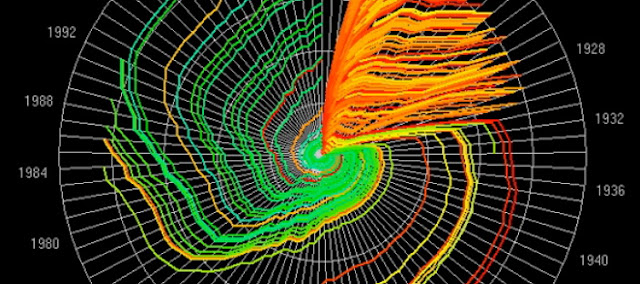Sometimes you have to take a step back and take a look around a science lab to appreciate the wealth of knowledge and research being carried out. Rank Clocks by Professor Mike Batty here at CASA, The Bartlett, University College London, is a prime example.
A rank clock is a device for visualising the changes over time in the ranked order of any set of objects where the ordering is usually from large to small. The size of cities, of firms, the distribution of incomes, and such-like social and economic phenomena display highly ordered distributions. If you rank order these phenomena by size from largest to smallest, the objects follow a power law over much of their size range, or at least follow a log normal distribution which is a power law in the upper tail.
Mike has examined the UK urban system from 1901 to 2001, the World System from 430BCE to 2000, and the Ancient World System from 3700BCE to 1000BCE. All these examples show quite regular stability in rank size at the aggregate Zipf Plot level but much greater volatility in terms of the Rank Clocks and this in an of itself throws grave doubt on the issue of universality and regularity in such systems. Moreover it opens up once again the paradox of why systems show such regularity at the macro level when everything is changing at the micro level.
We detail the rank clock illustrating how the rank of cities in the USA changed between 1790 and 2000 below:
Rank clock for US cities from Michael Batty on Vimeo.
In fact for cities and other phenomena such as the distribution of word frequencies, George Kingsley Zipf as long ago as the 1930s characterised such distributions as characterising pure power laws in which the size of an object seemed to approximate the largest object in the set divided by the rank of the object in question. Such strict power laws in fact seem to be the exception rather than the rule but many such rank size distributions seem to follow such laws in their upper tail, and hence these are taken as signs of system stability, self-organisation and universality.
Below we illustrate the animation of a rank clock of the top 100 high buildings in New York change between 1912 and 2008:
Rank clock of the top 100 high buildings in New York from Michael Batty on Vimeo.
However, despite the fact that such distributions are so regular even through time, when one examines how objects within these distributions change over time, it is quite clear that somehow these systems remain stable at the aggregate level but with objects which composes them shifting quite dramatically from time period to time period.
You can also download CASA Working Paper 152 Visualising Space-Time Dynamics in Scaling Systems. (pdf).
Thanks go to http://gisagents.blogspot.com/
